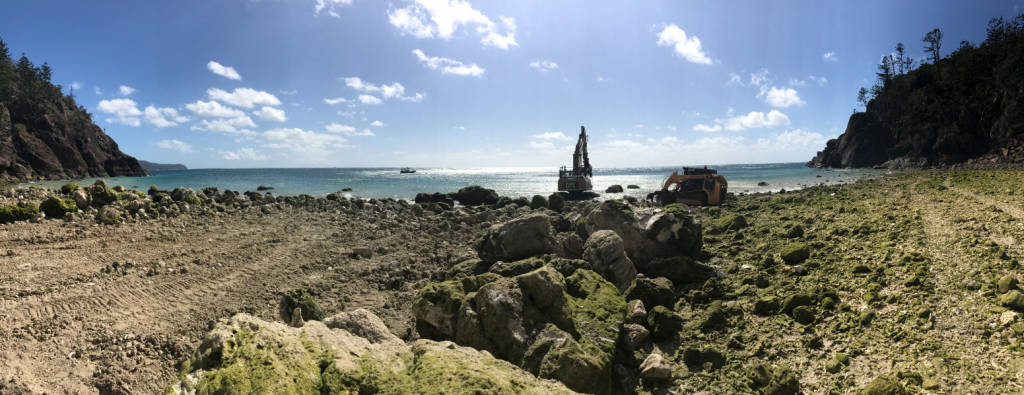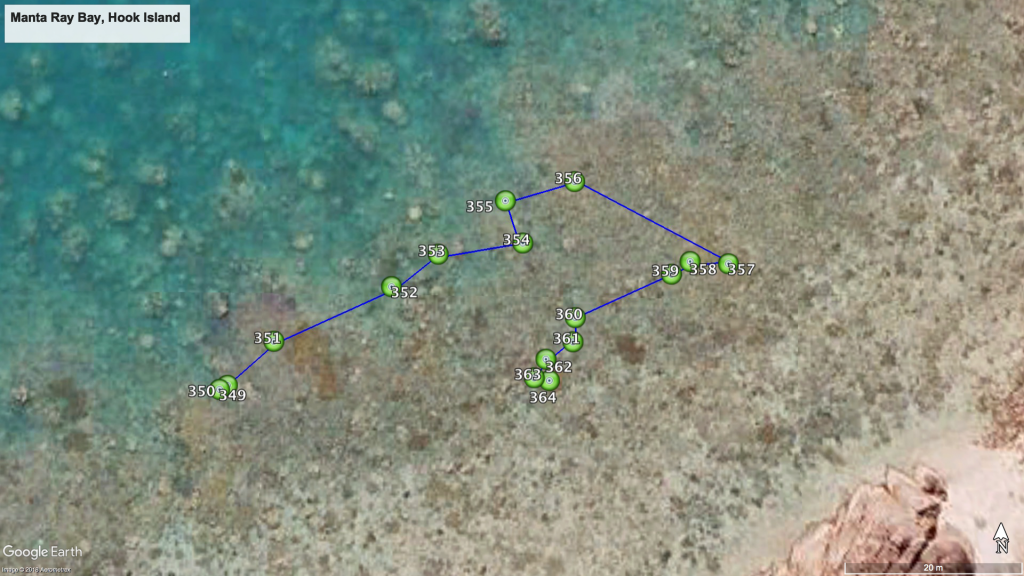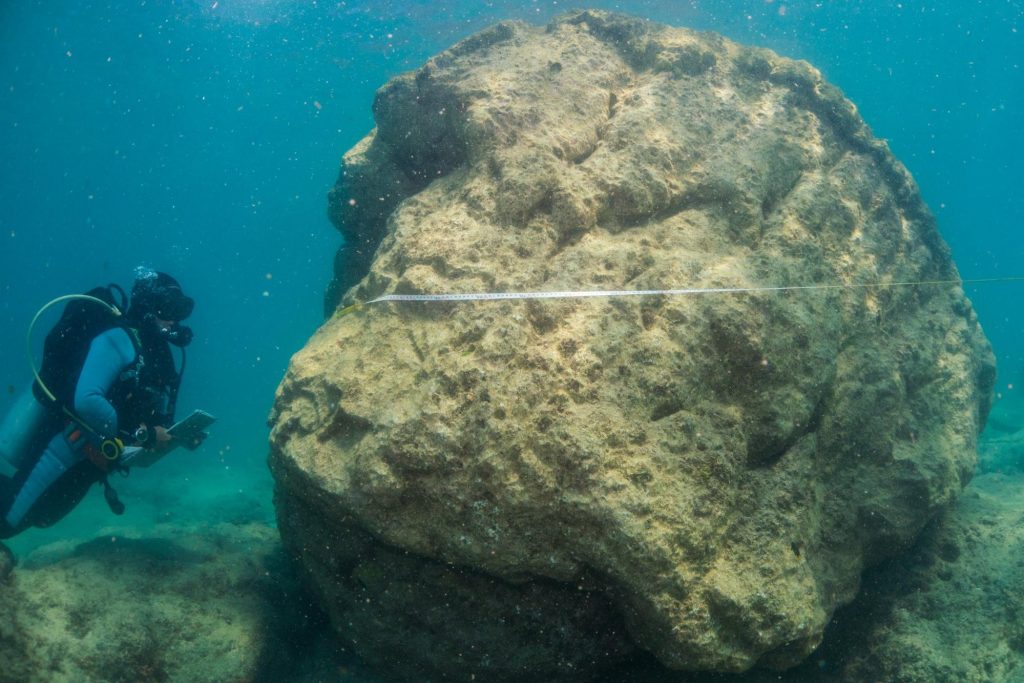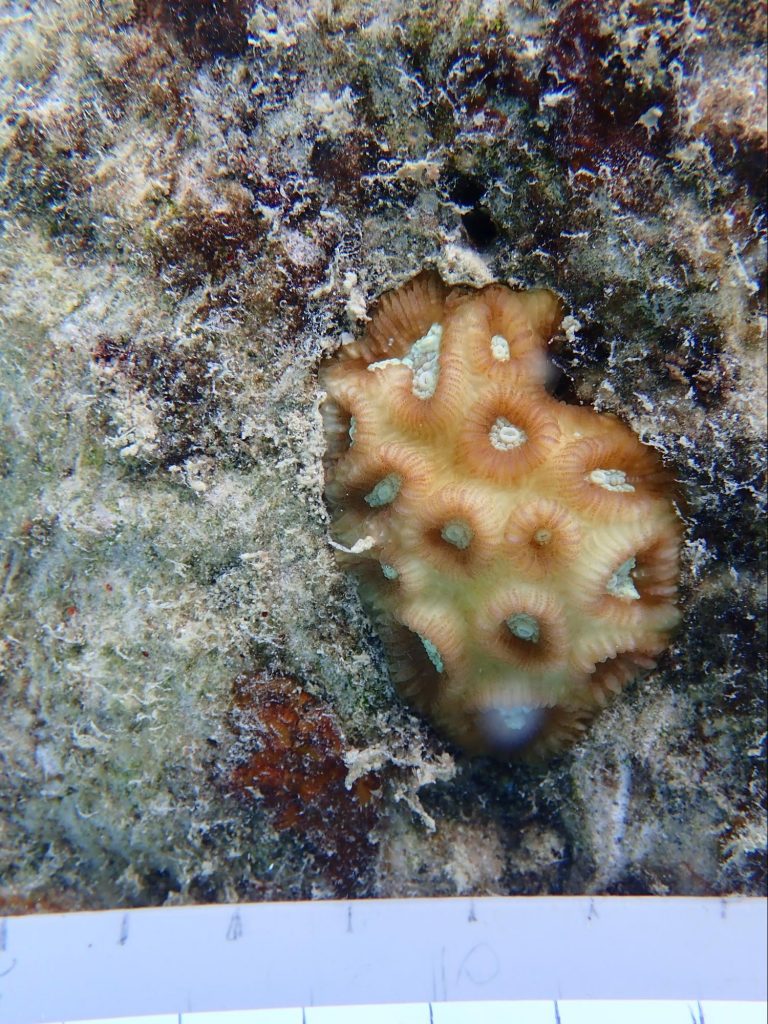How We Pushed 400 Tons of Coral Back into the Ocean after a Cyclone
Location
Manta Ray Bay, Hook Island, Whitsunday Islands, Queensland, Australia
The challenge
The Whitsunday Island group supports approximately 6,000 hectares of fringing coral reefs. It is one of the most highly valued and used regions of the Great Barrier Reef Marine Park for tourism and recreational activities. Manta Ray Bay, at the northern end of Hook Island, is an iconic area for tourism due to the easily accessible fringing reef, its status as a no-take marine reserve (green zone), and the high density of large reef fishes. An important feature of the site is the large Porites coral ‘bommies’ (large individual coral colonies) which provide high complexity habitat where reef fishes tend to aggregate. On the 28th of March 2017, the Whitsundays were hit by severe tropical cyclone Debbie (Category 4; 225-279 km/h winds). This resulted in widespread damage to island and marine habitats (including coral communities and tourism infrastructure.

Large coral heads or ‘bommies’ pushed onto shore after Hurricane Debbie. Credit: Queensland Parks and Wildlife Service

Location of Manta Ray Bay, Whitsunday Islands. Photo © Google Earth
Manta Ray Bay was in the direct pathway of the cyclone and the amount of energy delivered by the storm was enough to pulverize branching corals and to dislodge and push many of the large coral bommies high into the intertidal zone. These exposed Porites bommies ranged in size from 0.5 m to 2.5 m in diameter. High mortality of live coral tissue in the intertidal area occurred during the following days. The loss of the large bommies was perceived as a loss of one of the unique aspects of Manta Ray Bay and in their new location they restricted beach access for small vessels.
Actions taken
Queensland Parks and Wildlife Service (QPWS) and Great Barrier Reef Marine Park Authority (GBRMPA) staff, through the joint Field Management Program (funded by both the Queensland and Australian governments), were asked by commercial operators from the tourism industry if the bommies in Manta Ray Bay could be relocated back into the subtidal environment. The intention under this action is that this would provide structure for future coral larvae settlement, attract fish, and improve site access and aesthetics.
One of the ecological risks identified was that physically moving the heavy bommies would damage live coral along the path. However, a preliminary benthic survey conducted by QPWS Marine Parks staff estimated that the Manta Ray Bay reef flat was only supporting approximately one percent live coral cover post cyclone Debbie. Following this, a broader site assessment was conducted which included safety, biosecurity, ecological and environmental considerations. A cost/benefit and feasibility analysis was conducted to assess if moving the bommies would be the best option. The estimated costs of two days of use of earthmoving equipment and supporting barge were deemed to be off-set by the projected benefits: habitat restoration, improved aesthetics and beach access to a highly popular location, ongoing access to public moorings, increased understanding of coral recruitment/recovery and demonstration of proactive management after an extreme weather event.
A preliminary decision was made to proceed with the proposal of relocating the coral bommies back below the low water mark with the stated objectives of: (1) increasing substrate available for potential coral larval settlement in the future and habitat complexity to support fish and other biodiversity, and (2) improving the aesthetics and access to Manta Ray Bay Beach. Once a scope of works was agreed, GBRMPA assisted with the provision of a rapid authorisation to the state government (QPWS) under Part 5.4 of the Great Barrier Reef Marine Park Zoning Plan 2003 (Zoning Plan). This part of the Zoning Plan allows for the GBRMPA to undertake, or authorise third parties to undertake, specific management activities on their behalf. This section of the Zoning Plan is increasingly being used to assist management as more direct reef restoration and rehabilitation activities and trial restoration programs are undertaken.
Highly experienced excavator and compact track loader operators were engaged to reposition the bommies back into the subtidal environment by rolling them over the reef flat at a very low tide. A 30 ton long-arm excavator was then used to push the bommies past the reef crest and over the slope using the full ten metre extension of the excavator arm. In order to maximise site operations during the low tide window, a four ton compact track loader equipped with a grab bucket was utilised to push coral rubble and smaller bommies substrate into the subtidal area of the fringing reef flat. All biosecurity inspections of earth moving equipment (prior to barge loading and site works), on-site operations and works were directly supervised by QPWS Marine Park’s personnel. Over two days (20-21 June 2017), an estimated 100 cubic metres of dead coral substrate (equating to approximately 400 tons) was placed back into the water below the low water limit.

A compact track loader and excavator equipped with grab buckets were used to move and reposition the coral bommies back into the water during the low tide. Photo © Queensland Parks and Wildlife Service
How successful has it been?
Post-deployment monitoring
A follow-up site assessment was undertaken by QPWS staff on 4 August 2017 that showed that the bommies were stable and safe for in-water activities. After this the site began to be visited again by snorkel tourism operators, who described fish communities that included large schools of fusiliers, trevally, hump-headed Maori wrasse and herbivorous fish species.
Baseline assessment – (16 months later)
In order to assess the ecological effects and potential benefits of repositioning the bommies, researchers from James Cook University conducted a rapid baseline ecological survey of the bommies in October 2018, approximately 16 months after they were repositioned. The objective of the baseline survey was to quantify the cover of remnant live coral tissue on each bommie, the degree of coral recruitment to the bommies, and the fishes that were associating with the bommies.

Location of surveyed coral bommies. Photo © Queensland Parks and Wildlife Service
Methods
For the coral survey, each bommie was treated as an individual sampling unit (replicate). The total cover of remnant live coral tissue was visually estimated for each bommie. All juvenile corals (recruits) that had settled onto the bommies since June 2017 (between 1 cm and 15 cm in diameter) were identified to genus level.
All surveyed bommies were massive growth form Porites sp. colonies. The smallest of the bommies were approximately 1 m in diameter and the largest were approximately 2.5 – 3 m in diameter. Fishes were surveyed along a single 120 m transect that was run alongside the bommies, beginning at bommie 349 and ending at bommie 363 (Figure 6). All fishes that were associating with the bommies, and within a 4 m wide zone around the transect (total survey area of 480 m2), were recorded to species.
Remnant coral tissue on repositioned bommies
The majority of surveyed bommies (16 out of 22, 73%) had some original live coral tissue remaining. The cover of remnant live coral tissue on each surveyed bommie ranged from 0-20%, with a mean across all bommies of 5.9% (± 1.6%). Many of the bommies were in an inverted position (upside down) at the time of the survey. There may have been additional live coral tissue remaining if the bommies had been repositioned in their correct orientation. Porites sp. colonies have the capacity to recover through asexual reproduction of remnant coral polyps, and to overgrow the underlying skeletal structure and recolonise dead sections of the colony, provided that these sections are not overgrown by macroalgae or other sessile organisms.
It is possible that the cover of remaining live coral tissue on the surveyed bommies will slowly expand and regrow over the dead sections of the colonies. The rate of remnant live tissue expansion is variable, and is influenced by numerous factors, including water quality, rates of algal grazing and coral scraping by reef fishes, future disturbances such as coral bleaching, flood plumes or cyclones, settlement of coral recruits to the dead sections of the bommies and the growth and expansion of those new colonies. Future surveys of the repositioned bommies should include estimates of the total percent cover of remnant Porites coral tissue on each of the bommies.

Surveying repositioned coral bommies. Photo © David Williamson
Coral recruitment to the repositioned bommies
Approximately one-third (8 out of 22, 36%) of surveyed bommies had at least 1 recruit coral colony present. Four bommies had at least two coral recruits present and one bommie had six coral recruits. Coral recruits ranged in size from approximately 3 cm to almost 15 cm in diameter. Overall, ten coral genera were represented in the recruit colonies and included Acropora, Pocillopora, Cyphastrea, Favia, Favites, Goniastrea, Psammocora and Hydnophora. Given that the bommies were repositioned in June 2017, and that only one coral spawning season had elapsed prior to this baseline survey, it was encouraging to record the presence of a range of species of coral recruits on the bommies. It is likely that there will be continued growth of the existing recruit colonies, and additional recruitment of corals to the bommies, if favourable conditions persist during the upcoming summer monsoon season and beyond. Future surveys of the repositioned bommies should include measures of the maximum diameter of all coral colonies recorded growing on the bommies.

Coral recruits found on repositioned coral bommies. Photo © David Williamson
Reef fishes associated with the repositioned bommies
Twenty species of reef fish from within eight genera were recorded on the single transect through the repositioned bommies. The fish genera represented were Acanthuridae (surgeonfishes), Chaetodontidae (butterflyfishes), Labridae (wrasses), Lutjanidae (snappers), Pomacanthidae (angelfishes), Pomacentridae (damselfishes), Scaridae (parrotfishes) and Siganidae (rabbitfishes). Damselfishes were the most abundant group, with the planktivorous Neopomacentrus bankieri being the most abundant species and the territorial herbivore Pomacentrus wardi being the second most abundant species. Roving herbivorous fish species, particularly Acanthurus grammoptilus, Siganus doliatus and Scarus rivulatus were observed grazing on the repositioned bommies and on the surrounding substrate. Numerous fish grazing scars were observed on all of the 22 surveyed bommies. Although algal turfs were growing on most areas of the dead coral bommie skeletons, the observed level of grazing pressure by reef fishes appeared to be effectively limiting the growth of algal turfs. Furthermore, no macroalgae were observed growing on the repositioned bommies or on the surrounding reef flat at Manta Ray Bay.
Lessons learned and recommendations
Overall, it should be considered that the repositioning of the Porites bommies displaced at Manta Ray Bay during cyclone Debbie has delivered positive environmental and social benefits. Vessel access has effectively been restored to the beach, some remnant coral tissue on most of the bommies has been preserved, colonisation of the bommies by coral recruits has begun, and habitat structure has been maintained for reef fishes. Furthermore, the bommies provide three-dimensional habitat structure on the outer reef flat, and as the coral community develops on the bommies, and greater numbers of fishes associate with them, the shallow-water snorkelling experience for tourists will be enhanced.
We recommend that each of the bommies on the reef flat at Manta Ray Bay be permanently tagged and that the area be accurately mapped using diver-towed GPS, satellite imagery and GIS software. This will ensure accurate identification of each bommie and facilitate robust ecological monitoring of the area. It will also be possible to monitor any movement of bommies following any further extreme weather events.
We also recommend that future surveys of the bommies should be conducted at similar tidal height to this baseline survey (2 – 3 m above LAT), and at a similar time of year (October or November).
Given that many of the surveyed bommies were in inverted positions (upside down), future restoration activities to reposition displaced Porites bommies should endeavour to orientate the bommies correctly. Correct orientation is likely to enhance recovery of remnant coral tissue.
In addition:
- The bay should continue to be managed as a ‘no anchoring area’ with public moorings maintained. This will minimise the risk to recovering corals from anchor damage.
- This site may now be suitable for trial coral restoration techniques (e.g. larval enhancement, ‘coral gardening’) to accelerate recovery.
- Time is a critical factor when seeking to increase survivorship of live impacted corals post impact. I.e., the faster they can be restored, the better!
- Site impact assessments were an important factor in expediting approvals to undertake the works.
- Manta Ray Bay is in a ‘Green Zone’ of the GBR and is therefore protected from fishing pressure. High numbers of grazing and herbivorous fishes may contribute to coral recovery by keeping down levels of algae turf and macroalgae that may compete for space. Monitoring the level of macroalgae growth on the bommies should be part of yearly monitoring.
Funding summary
This project was funded through (State/Commonwealth) disaster recovery funding made available post Cyclone Debbie. Total costs for the intervention works (earthmoving machinery, barge services and labour) were approximately AU$30,000. The cost of the baseline monitoring survey conducted 16 months after the bommie repositioning works was approximately AU$4500. This baseline assessment was provided in-kind by the ARC Centre of Excellence for Coral Reef Studies, James Cook University, using funding from the Reef 2050 Integrated Monitoring and Reporting Program (RIMReP). The completion of this case study was supported in-kind through TropWATER, James Cook University and funded through the National Environmental Science Program Tropical Water Quality Hub.
Lead organizations
Queensland Parks and Wildlife Service
Great Barrier Reef Marine Park Authority
Partners
James Cook University
National Environmental Science Program, Tropical Water Hub


